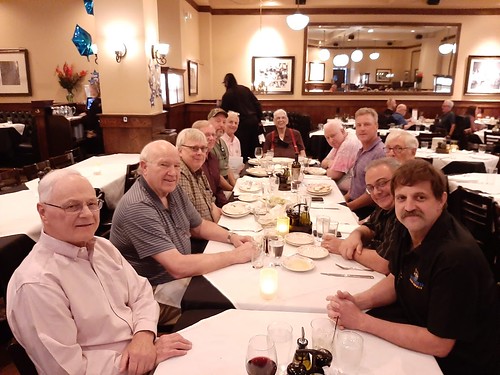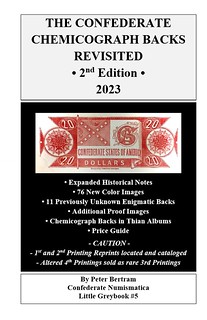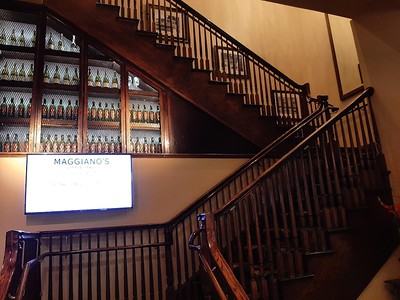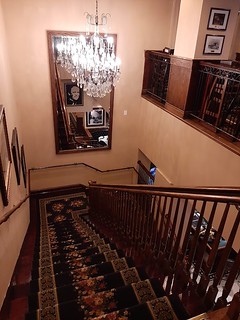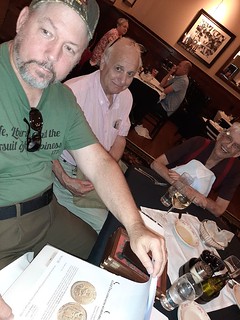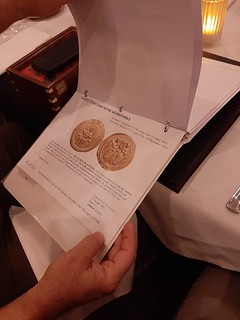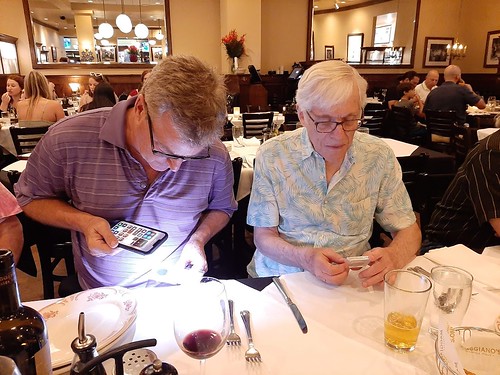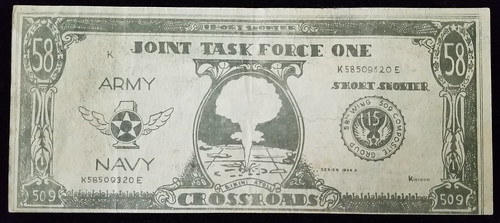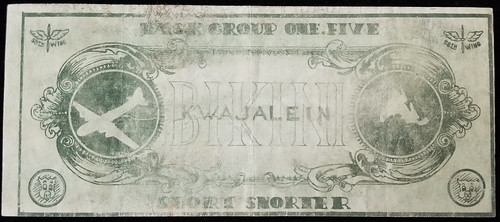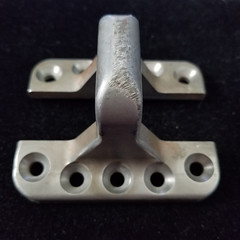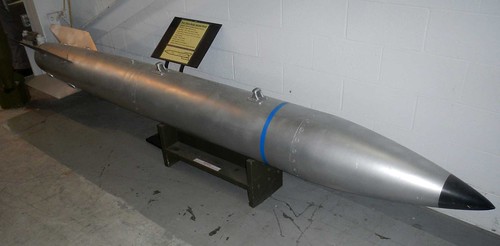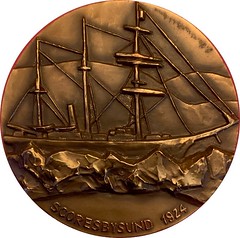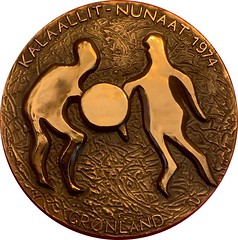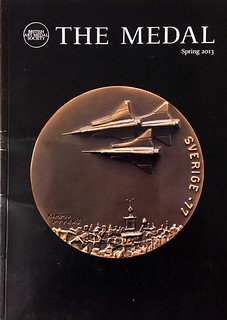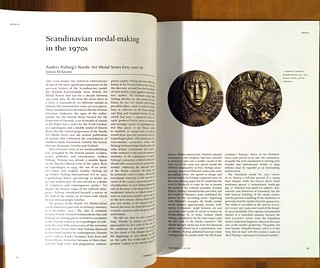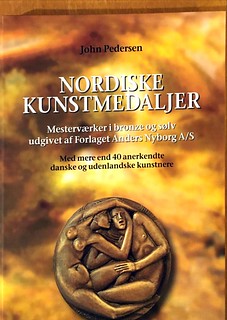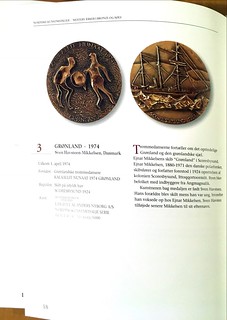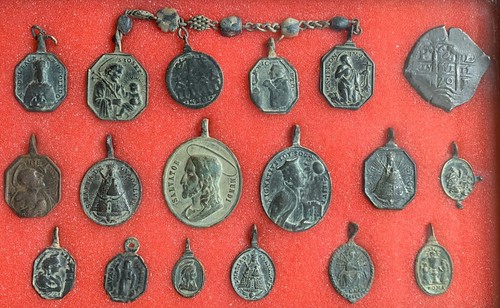
PREV ARTICLE
NEXT ARTICLE
FULL ISSUE
PREV FULL ISSUE
WAYNE'S NUMISMATIC DIARY: JULY 23, 2023Tuesday July 18, 2023 brought the monthly meeting of my Northern Virginia numismatic social group Nummis Nova. Mike Packard was our host, and he chose Maggiano's Little Italy in the Galleria at Tyson's II mall. This was the site of our second meeting in November 2007, a memorable event where many of us met for the first time (the initial gathering the month before was just myself, Roger Burdette and Wayne Herndon). Here's a group shot of the whole crew. Clockwise from left: Lorne Lavertu, Mike Packard, Jon Radel, Wayne Homren, Tom Kays, Tom's guest Mike Markowitz, Julian Leidman, Steve Bishop, Daryl Haynor, Dave Schenkman, Eric Schena and Wayne Herndon.
To read the earlier E-Sylum article, see:
Here are some of my photos from the evening. We ate downstairs, but I checked out the staircase to the empty upper level. Here Tom Kays and Mike Markowitz review a binder with a copy of Mike's presentation for an upcoming Fairfax Coin Club meeting. A great way to preserve and memorialize a presentation - I wish I'd thought to do that with my own presentations. Daryl Haynor and Dave Schenkman examine coins.
The Nuclear Option Eric writes: "I passed around two things, one numismatic and the other not so much (though related to a discussion at the previous Nummis Nova). The first item is a souvenir short snorter from Operation Crossroads, the first postwar nuclear weapon test series in the South Pacific at Bikini Atoll in the Marshall Islands. There were a couple of different issues of these souvenir notes, this one highlights the 56th Wing of the 509th Composite Group in Joint Task Force 1.
"Crossroads was a planned series of three tests in July 1946 of Eric adds:
"My father used to flight test nuclear weapon drop shapes and the like back in the 1970s and early 1980s and I gave him one (he knew instantly what it was). It's an interesting piece of Cold War history, a subject matter that I have a keen interest in, in addition to my numismatic fields. I am also including a pic of a B61 in a museum that clearly shows the lugs." Wow - memorable exhibits! On Friday my son Chris and I went to see the new "Oppenheimer" movie. While long at 3 hours it doesn't seem so and moves quickly with tremendous performances by an all-star cast. Great historical drama set in the recent past, with some racy scenes you probably won't find in the Barbie movie. The B61 lug was an interesting tangible reminder of the ongoing Cold War, as was Alamo's footage of children practicing bomb drills in school hallways, something I remember firsthand from the 1960s. -Editor
Tom's Medals Tom Kays writes: "Tom writes: In honor of Jon's enthusiasm for collecting Scandinavian medals, I brought a medal of Greenland that has Scandinavian roots for him to appreciate. Jon already has this medal and explained that it is comparable to Franklin Mint products, meaning many are available with too few collectors looking for it. I like it regardless, researched its history, and provide you a full description and explanation of this chunky, bronze hockey puck."
Commemorative Medal of the 50th Anniversary
of the Settlement at Scoresby Sund, Greenland
Jon Radel writes: "For those whose interest in the Nordiske Kunstmedaljer Serie (Nordic Art Medal Series), 54 medals issued between 1973 and 1983 (roughly--there are fewer or more depending on how pedantic you wish to be), was piqued by Tom Kays' medal there are several sources on the series. The best English overview I know of is Simon McKeown, "Scandinavian medal-making in the 1970s: Ander Nyborg's Nordic Art Medal Series forty years on," The Medal, No. 62 Spring 2013, pp 18-39. The most comprehensive work I know of is in Danish: John Pedersen, Nordiske Kunstmedaljer: Mestervaerker i bronze og sølv udgivet af Forlaget Anders Nyborg A/S, Dansk Numismatisk Forening 2021. "It is possible to acquire copies from the publishers. A couple of scans should give you a sense of the works."
For more information, or to order, see:
Tom adds: "A frame of old, excavated, religious medallions and a partial rosary with Catholic icons of Spain and Latin America was also seen making the rounds at dinner with Christ and the Virgin Mary, Saint Ignatius of Loyola, Saint Joseph, Saint Jerome, the Virgin of Guadalupe, and others. A 1670-dated, four reales of Potosi is included for size comparison. These types of Catholic medallions were worn in the 16th and 17th centuries and were often incorporated into rosaries to aid in devotions to people or events being brought to mind. Similar Spanish and Spanish Netherlands (Dutch) medallions were found in excavations at James Fort at Jamestown. "In Protestant England, an Act of 1571 prevented English citizens from owning or selling Catholic devotional items imposing harsh penalties up to the death penalty. Perhaps these excavated examples were lost by German, Polish, Dutch, or Spanish travelers, soldiers, or settlers. These are lost heirlooms of the Catholic tradition." Another excellent evening of numismatic fellowship, with great food and drink to boot. I expect to see several of these folks along with many loyal readers like you at the ANA show in Pittsburgh next month. Stop by the NBS events or the tables of NBS, Julian Leidman or Wizard Coin Supply to say hello. Julian will be our dinner host next month in his home state of Maryland.
Wayne Homren, Editor The Numismatic Bibliomania Society is a non-profit organization promoting numismatic literature. See our web site at coinbooks.org. To submit items for publication in The E-Sylum, write to the Editor at this address: whomren@gmail.com To subscribe go to: https://my.binhost.com/lists/listinfo/esylum All Rights Reserved. NBS Home Page Contact the NBS webmaster 
|
